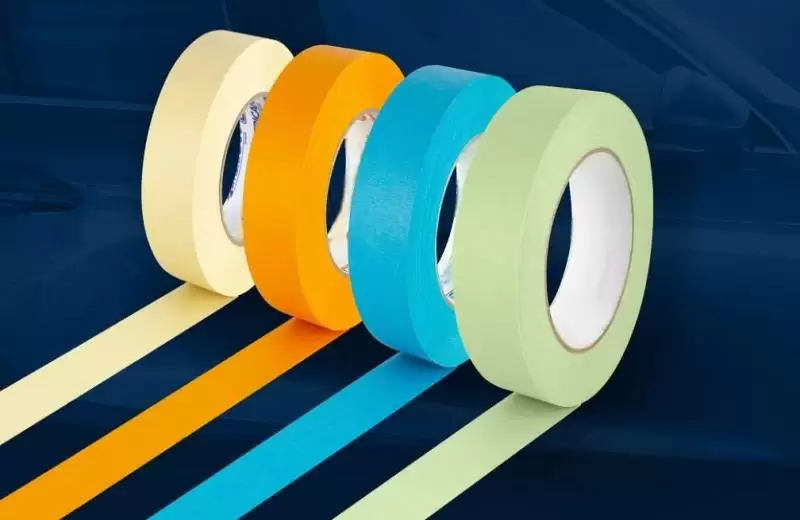
Have you ever walked through an auto body shop and noticed the rainbow of masking tapes covering different parts of vehicles? What appears to be random color choices actually represents a sophisticated color-coding system that professional painters and technicians rely on daily. At QKD, we understand that choosing the right masking tape isn't just about color preference - it's about selecting the proper tool for specific automotive applications.
Understanding the Color Spectrum: More Than Just Aesthetics
Each masking tape color represents different performance characteristics, temperature resistance levels, and specialized applications. Let's break down what each color means in the automotive context:
Blue Masking Tape: The General Workhorse
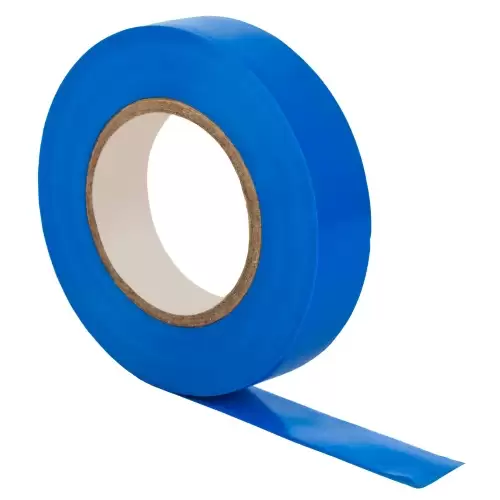
The most recognizable color in automotive masking, blue masking tape typically features crepe paper backing with rubber-based or acrylic adhesive. With temperature resistance ranging from 60°C to 80°C, it's perfect for:
• Masking off windows, trim, and wheels
• Base coat and color coat applications
• Temporary holding applications
• General protection during detailing
While economical and reliable for short-term use, standard blue masking tape shouldn't be used for clear coat applications or high-temperature environments.
Green Masking Tape: The Reliable Performer
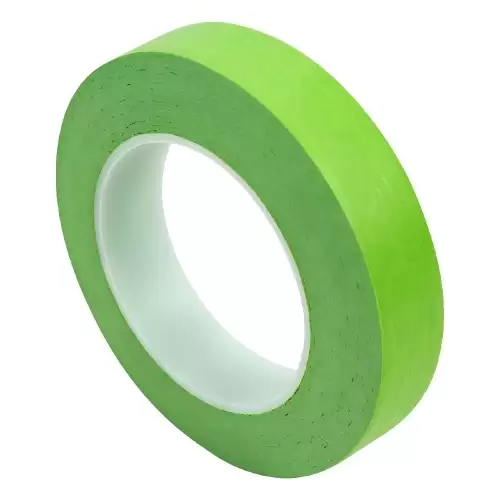
Similar to its blue counterpart in temperature resistance, green masking tape often features slightly upgraded adhesives. Automotive professionals frequently use it for:
• Extended masking periods
• Sensitive surfaces requiring medium adhesion
• Areas requiring better solvent resistance
• Secondary masking layers
Yellow Automotive Masking Tape: The Middle Ground Solution
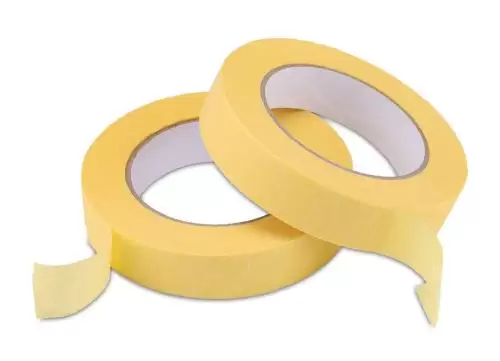
When you see light yellow or beige tapes in the shop, you're looking at medium-temperature resistance solutions. With temperature tolerance from 90°C to 110°C and high-performance acrylic adhesives, yellow automotive masking tape excels in:
• Clear coat applications
• Low-bake environments (60-80°C paint rooms)
• Medium-term masking projects
• Situations requiring clean removal
At QKD, our yellow automotive masking tape has become a shop favorite for its balanced performance in standard refinishing work.
Brown Masking Tape: The Heavy-Duty Option
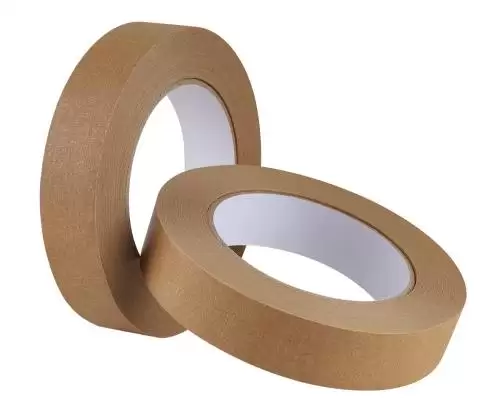
Often overlooked but incredibly valuable, brown masking tape typically offers enhanced strength and temperature resistance. Its applications include:
• High-strength masking requirements
• Heavy vinyl and decal applications
• Rough surface adhesion
• Industrial automotive applications
Black Masking Tape: The High-Performance Specialist
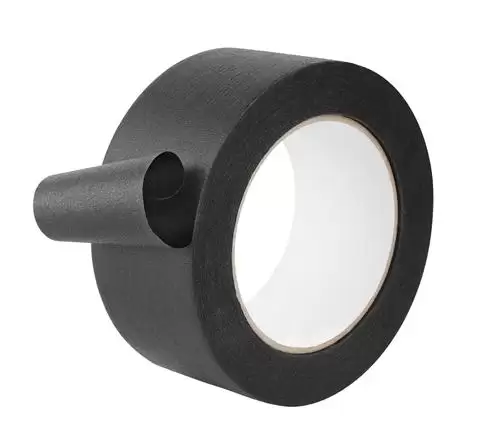
When the job demands serious temperature resistance, black masking tape delivers. With high-strength crepe paper or composite backing and high-temperature acrylic adhesive (120°C to 150°C), it's essential for:
• Original equipment manufacturer (OEM) clear coat processes
• High-temperature baking cycles
• Extended baking durations
• Critical edge definition
QKD's black masking tape provides the confidence needed for demanding refinish environments where failure isn't an option.
White Masking Tape: The Delicate Surface Protector
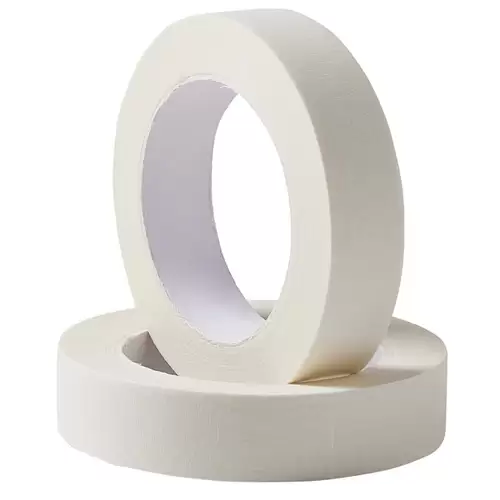
Pure white masking tape represents the ultimate in surface protection. Typically featuring plastic film (PE/PVC) backing with specialized acrylic adhesive, it's specifically designed for:
• Freshly painted surfaces
• Delicate trim and moldings
• Headlight and taillight protection
• Chrome and polished surfaces
• Sensitive electronic components
The ultra-low residue adhesive ensures no damage occurs to even the most fragile surfaces.
Beyond Color: Understanding the Technical Differences
While color provides quick visual identification, the real differences lie in the technical specifications:
Adhesive Technology: The Heart of Performance
The adhesive type determines everything from temperature resistance to clean removal. Rubber-based adhesives offer strong initial tack but often leave residue, especially after heat exposure or extended application periods. Acrylic adhesives, used in higher-grade tapes like QKD's professional series, provide stable performance over time and clean removal even after baking cycles.
Backing Materials: More Than Just Paper
Standard crepe paper offers excellent tearability and conformability to complex contours. High-strength crepe papers and composites, used in dark green and pink tapes, provide exceptional tensile strength for large area masking. Plastic film backings, found in white and bright yellow tapes, deliver superior scratch resistance and surface protection.
Edge Seal: The Professional's Secret Weapon
High-performance tapes feature precisely engineered edges that prevent paint bleed-through. This characteristic is crucial for creating sharp lines in custom painting, stripes, and graphic applications. QKD's premium masking tapes undergo strict manufacturing controls to ensure perfect edge sealing every time.
Application Guidelines: Choosing the Right Color for the Job
1.Fresh Paint Protection
For newly painted surfaces requiring protection during assembly or additional paint work, white masking tape with plastic film backing is essential. The low-tack adhesive prevents imprinting while the smooth surface resists scratches.
2.High-Temperature Environments
When working near body filler applications or in high-bake conditions, pink high-temperature masking tape provides the necessary heat resistance (150°C to 180°C+) while maintaining clean removal characteristics.
3.Precision Masking
For sharp lines and crisp edges in custom painting, dark green or black masking tape with superior edge seal characteristics ensures professional results without touch-ups.
4.Everyday Masking
Standard blue and green masking tapes handle routine masking tasks economically while providing reliable performance for most shop environments.
The QKD Difference: Engineering Excellence in Every Roll
At QKD, we approach masking tape manufacturing with the same precision that automotive professionals bring to their work. Our color-coded masking tape system isn't just about appearance - it's a comprehensive solution designed to meet the specific demands of modern automotive refinishing.
Each QKD masking tape undergoes rigorous testing for:
• Temperature resistance verification
• Adhesion performance under various conditions
• Clean removal characteristics
• Solvent resistance
• Tensile strength and conformability
Making the Right Choice: Practical Scenarios
Scenario 1: Complete Vehicle Respray
For a full vehicle respray involving base coat and clear coat with baking cycles, professionals might use:
• Blue masking tape for initial masking of windows and trim
• Yellow automotive masking tape for areas receiving clear coat
• Black masking tape for critical edges and high-temperature areas
Scenario 2: Spot Repair
For localized repairs involving blending and clear coat application:
• White masking tape for protecting adjacent fresh paint
• Green masking tape for general masking
• Yellow automotive masking tape for clear coat boundaries
Scenario 3: Commercial Fleet Maintenance
For high-volume fleet work requiring efficiency and reliability:
• Standard blue masking tape for general protection
• Brown masking tape for heavy-duty applications
• Selected specialty tapes for specific challenges
Frequently Asked Questions
Q: Can I use blue masking tape for clear coat applications?
A: While possible for short-term masking, blue masking tape lacks the temperature resistance needed for baked clear coats. Yellow or black masking tape provides better performance and cleaner removal.
Q: How long can I leave masking tape on a vehicle?
A: This depends on the tape type and environmental conditions. High-performance acrylic adhesive tapes can typically remain 7-14 days without issues, while rubber-based adhesives may begin leaving residue after 24-48 hours.
Q: Why does paint sometimes bleed under masking tape?
A: Paint bleed typically occurs due to insufficient edge seal, improper application technique, or using the wrong tape type for the application. High-quality tapes with engineered edges significantly reduce this risk.
Q: What makes white masking tape better for delicate surfaces?
A: White masking tape combines ultra-low residue adhesive with smooth plastic film backing that won't scratch or imprint sensitive surfaces like fresh paint or polished plastics.
Q: How important is temperature resistance in masking tape selection?
A: Extremely important. Using tape with insufficient temperature resistance can lead to adhesive transfer, difficult removal, and contaminated surfaces - potentially ruining a perfect paint job.
Conclusion: Color Your Way to Professional Results
Understanding masking tape colors transforms them from simple covering materials to precision tools in your automotive work. Each color in the spectrum represents specific performance characteristics designed to solve particular challenges in the shop.
At QKD, we've engineered our complete range of masking tapes to meet the exacting standards of modern automotive professionals. Whether you're performing quick repairs or show-quality custom work, having the right tape for each application ensures consistent, professional results while saving time and reducing comebacks.
